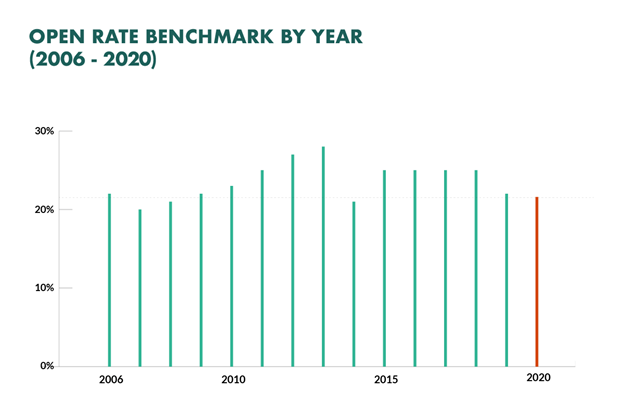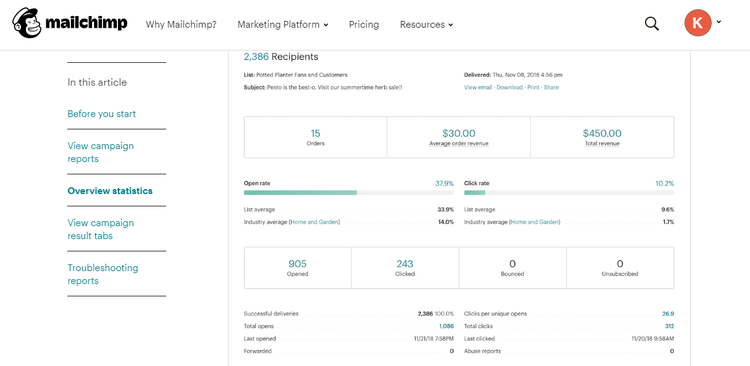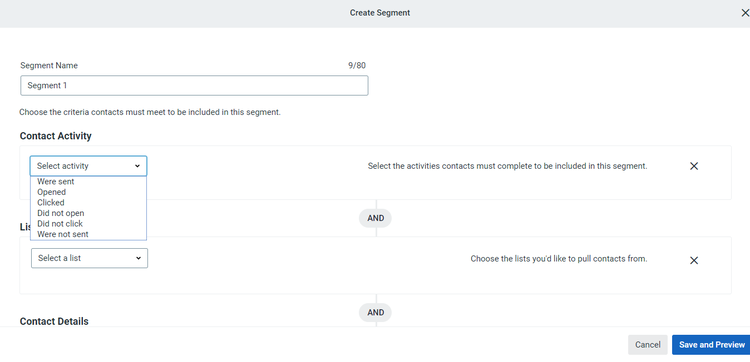People don’t give their email addresses to just anyone these days. We’re all being bombarded by emails, whether it’s ones we signed up for, ones we’re receiving because we forgot to tick (or untick) a box on a form, or ones we’re absolutely sure we never signed up for.
That makes creating and growing your subscriber list tricky. But it’s crucial if you want to run successful email marketing campaigns that reach people who are actually interested in your business. According to Optinmonster.com, the numbers speak for themselves:
- 99% of people in the U.S. check their email every day.
- Some people check their email as much as 20 times a day.
Email open rates are also, by and large, continuing to grow.

Email open rate benchmark by year from 2006 to 2020. Image source: Author
It’s not easy, but it’s not rocket science, either. We can help you understand how to best capture your customers’ details and get pride of place in your recipients’ inboxes with our trusty tips.
At a glance: Our best tips for growing your email list
- Tap into your own network
- Optimize subscription forms
- Incentivize signup
- Add share buttons
- Use paid ads and social media
What are email lists used for?
Despite the continuing popularity of social media apps, email marketing is still an incredibly useful channel for reaching customers. In fact, according to Wordstream.com, more than half of marketers say email is their most effective channel in terms of revenue generation.
Whether it’s generating brand awareness and gaining brand fans through regular email newsletters, announcing sales, recommending products, or sending cart abandonment reminders, email marketing offers many ways for a business to generate leads in their sales process.
However, the effectiveness of your email newsletters depends entirely on the list of subscribers to which you send them. Even if you create an eye-catching message with catchy copywriting, if you’re sending it to people who aren’t interested in your business, you won’t see results.
Think of it like this: If you run a pet store, sending email newsletters to people who are allergic to animals isn’t going to generate a ton of revenue.
Take the time to think about how you can capture the details of people who are likely to buy your products or services, now or in the future.
Where do businesses get their email lists?
There are two main ways a business can get an email list:
- Buy one from a third-party source
- Build their own from scratch
It’s tempting to buy customer data as it’s a quick and easy way to get your email marketing campaign off the ground, but don’t even think about it.
Building an email list organically takes a lot more time, but it’ll get better results, make your customers happy, and won’t see you slapped with fines for breaching data privacy laws.
1. Buying an email list
You know those emails you get that promise you’ll receive $1 million in your bank account if you just send over your account number? We all (hopefully) know by now that they aren’t to be trusted. If it seems too good to be true, it probably is.
The same applies to people who try to sell you ready-made email lists. “Great,” you might think, “now I don’t need to spend time building up my own email lists, and I can get started with email marketing straight away.” Some even promise free email lists.
But, not so fast.
Not only could you be breaking the law -- it’s a bit of a grey area, but it’s likely to violate the CAN-SPAM act in the U.S. and GDPR in the EU due to not obtaining expressed consent from the recipient -- it’s also unlikely to get you the results you’re looking for.
Put yourself in your customers’ shoes.
If you receive an email from a company you’ve never heard of, what would you do? At best, delete it. At worst, mark it as spam. Either way, sending emails to people who haven’t asked to receive them from your brand is a bad idea.
2. Building an email list
Building -- and growing -- a list of people who have opted in to receive emails because they want to hear from you and have a genuine interest in your brand will generate better leads and improve your conversion rates.
You also can get more relevant, granular details -- such as products they like and communication preferences -- that allow you to segment customers and send them highly targeted emails. Most companies that sell email lists provide only basic demographic information, such as age and location.
How to successfully grow an organic email list
There are a ton of ways you can take your email list from just your mom and your mailman to include lots of people who are interested in what you have to say and might, ultimately, buy your product.
1. Tap into your own network
Even if you have zero names on your email list right now, you can probably think of at least 10 people in your network who would be interested in receiving your newsletters.
But don’t send them an email without asking first.
Kent Lewis, president and founder of digital marketing agency Anvil Media, explains:
Send an email to contacts in your network asking permission to add them to your email newsletter list. You need to retain records of securing permission for compliance.
2. Optimize subscription forms
One of the first steps in building and managing your email list is to create what are called “subscribe forms” to capture your customers’ details. This could be in the form of a popup, a static web form, or a specially designed landing page. The design, copywriting, and position of these forms are crucial if you want a good signup rate.
Nicole Rohde, international PR manager at luxury fashion brand Maxwell-Scott, explains:
We optimized our homepage in order to make it easier for people to join our mailing list. We implemented a permanent sign up field at the bottom of every page. In addition to that, we created a newsletter sign-up pop up that triggers after 60 seconds on our website.
According to Corey Trojanowski, director of digital strategy at marketing agency Valve+Meter, it’s important to keep forms simple and make them quick to fill out:
Only ask for what you need…People think, ‘Well, in order to build my segmented lists I need all of this demographic information up front.’ That's not the case. If a company wants to build segments and get hyper personalized with their email marketing, there are ways to pull that information out of the user based on their actions and what they read or view on your website.
3. Incentivize signup
There is no such thing as a free lunch, and people normally don’t give away their contact details for free, either. You need to offer them an incentive and provide value. This could be in the form of an e-book, a webinar, or a competition.
Jamie Burns, VP of sales and co-owner of online sporting goods retailer BulkMunitions, explains the company’s strategy.
One of the best ways we've done this is through email marketing partnerships with other complementary businesses. This is either through co-sponsoring a giveaway or simply sponsoring a newsletter send.
4. Add share buttons
Word-of-mouth marketing drives results, as people are 90% more likely to trust and buy from a brand recommended by a friend. And what better way to grow your email list than to get your current (happy) subscribers to share your newsletters with their friends and family?
By putting share buttons at the bottom of your emails, people can easily send them to anyone they think would be interested, or share them on social media.
5. Use paid ads and social media
Just as no man is an island, no marketing channel should stand on its own. Your email newsletters should be just part of your omnichannel marketing strategy, where all channels work together to bring you more business.
You can use paid ads and social media to not only share your newsletters, but also drive people toward signup forms or landing pages where you can capture customer details. And as these people have already shown an interest in your company, they are highly valuable leads and subscribers.
How to manage and utilize your new email list
Less can definitely be more when it comes to managing your email list. Building a list doesn’t mean collecting as many email addresses as you can.
Carsten Schaefer, founder and CEO of social proof platform crowdy.ai, recommends pruning your lists regularly by removing subscribers who are not opening your emails or clicking any links.
Once every 6 months or so, make sure to delete these accounts. You’ll reduce your email marketing service provider bill, plus you will get better click-through and open rates.
Email marketing software, such as Aweber or SendPulse, can provide the necessary reporting and analytics functionality. Let's take Mailchimp as an example. They do a great job at helping you understand who is opening and engaging with your emails and who is inactive.

Mailchimp dashboard displaying analytics for an email campaign. Image source: Author
Once you have that information, you can set up a winback campaign to try to re-engage such recipients. If that doesn’t work, it’s time to remove them from your list.
As you grow your list, you can start to create segments based on past interactions and demographic information. This allows you to send more relevant, personalized emails to help boost click and conversion rates.
Doing this manually is an onerous task. Most email marketing services -- such as the example from Constant Contact below -- comes with segmentation functionality that allows you to create segments based on pre-defined characteristics with just one click.

Constant Contact allows users to segment their list by numerous characteristics. Image source: Author
Dynamic segmentation takes this one step further by adding and removing people from segments when they start -- or stop -- meeting your criteria.
For example, if someone hasn’t engaged with your brand for three months, they are automatically added to the win-back campaign segment. If they start engaging again, they are removed from that list.
Success is providing real value
There are no shortcuts when it comes to building an email list from scratch. It takes time and patience.
Still, five people who are interested in hearing from you is better than 1,000 people who couldn’t care less. It’s all about quality over quantity.
Once someone subscribes to your list, then the hard work continues, as you need to treat them well to keep them engaged. You’ve only got one chance to make a first impression.
This is why you need to send relevant content, personalize your emails, spend time perfecting the copywriting and design, and be useful and helpful.
Our Small Business Expert
We're firm believers in the Golden Rule, which is why editorial opinions are ours alone and have not been previously reviewed, approved, or endorsed by included advertisers. The Ascent does not cover all offers on the market. Editorial content from The Ascent is separate from The Motley Fool editorial content and is created by a different analyst team.